Project Proposal: Cultural Diversity and Woolworths Performance
VerifiedAdded on 2021/04/16
|19
|3239
|28
Project
AI Summary
This project proposal examines the impact of cultural diversity on the organizational performance of Woolworths Superstore in Melbourne CBD. The study aims to explore both the positive and negative impacts of a diverse workforce, investigate effective diversity management strategies, and provide recommendations for Woolworths to enhance its diversity management practices. The proposal includes a literature review discussing creativity, competitiveness, talent management, personal biasness, poor team management, and accommodation costs. It outlines the research objectives, justification, expected outcomes, conceptual framework, research hypothesis, methodology (including research design, strategy, data collection, and data analysis), project organization (Gantt chart), and budget. The research will utilize surveys and interviews to collect primary data from employees and managers, employing both qualitative and quantitative methods. The findings will be analyzed using statistical methods to provide actionable recommendations for Woolworths.
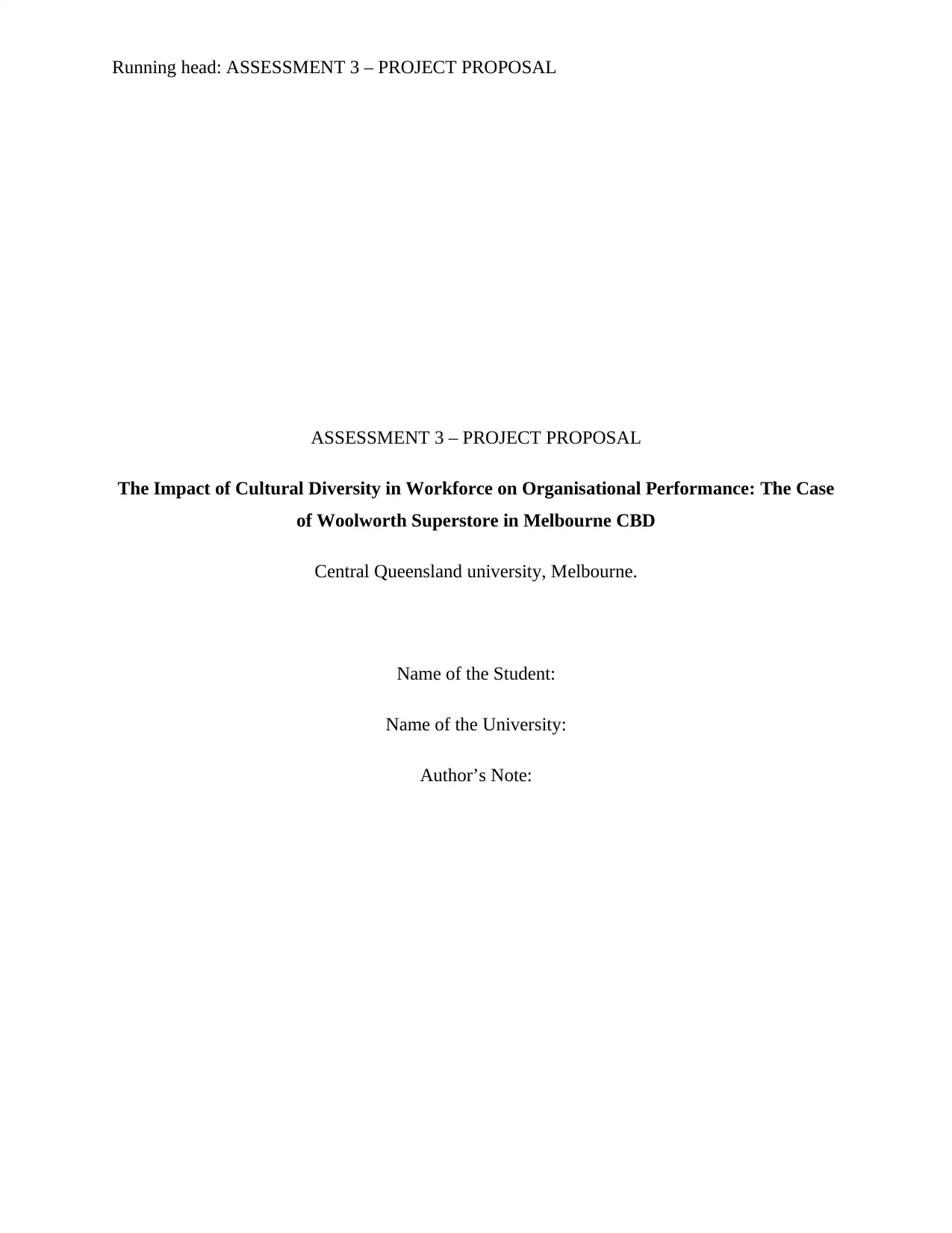
Running head: ASSESSMENT 3 – PROJECT PROPOSAL
ASSESSMENT 3 – PROJECT PROPOSAL
The Impact of Cultural Diversity in Workforce on Organisational Performance: The Case
of Woolworth Superstore in Melbourne CBD
Central Queensland university, Melbourne.
Name of the Student:
Name of the University:
Author’s Note:
ASSESSMENT 3 – PROJECT PROPOSAL
The Impact of Cultural Diversity in Workforce on Organisational Performance: The Case
of Woolworth Superstore in Melbourne CBD
Central Queensland university, Melbourne.
Name of the Student:
Name of the University:
Author’s Note:
Paraphrase This Document
Need a fresh take? Get an instant paraphrase of this document with our AI Paraphraser
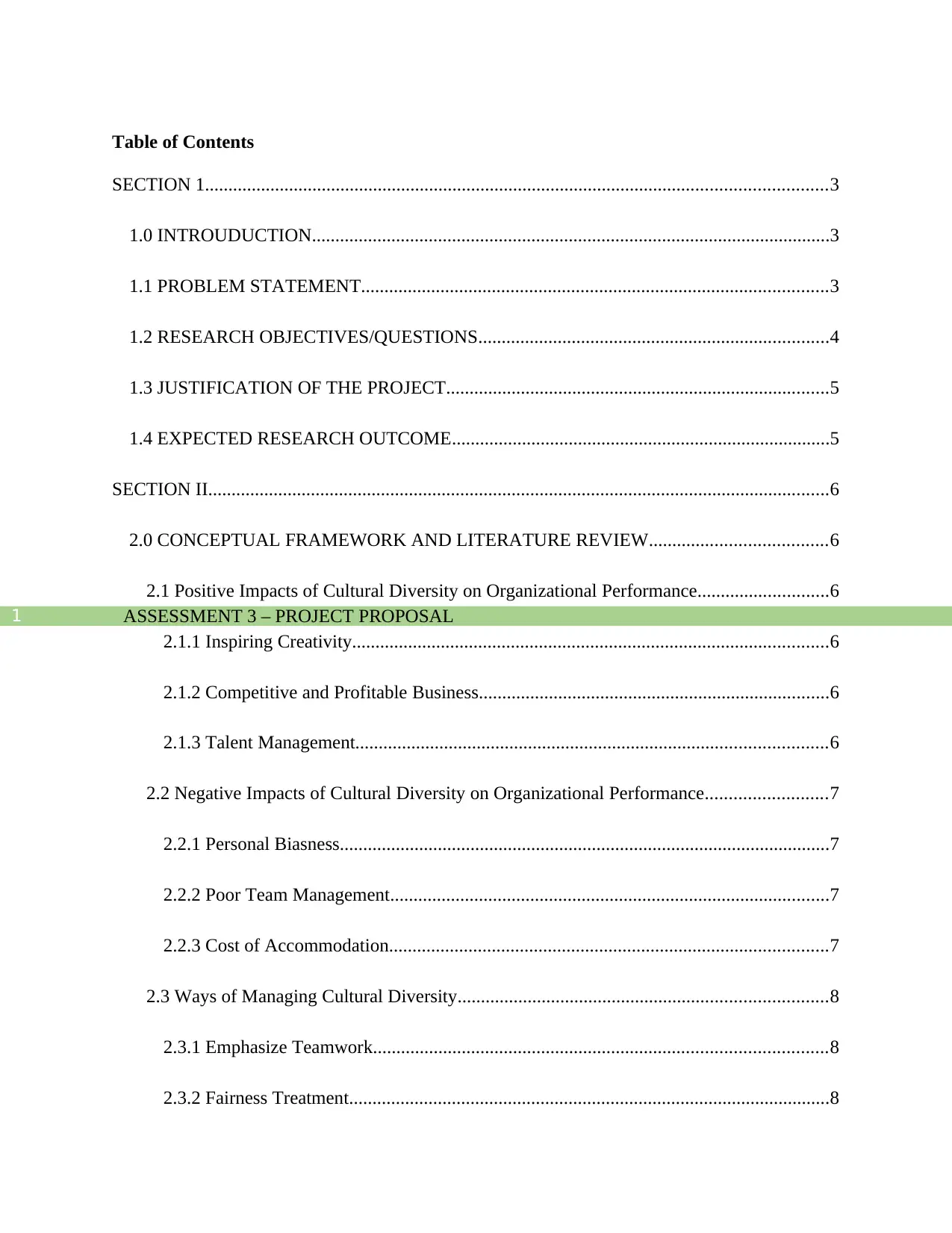
ASSESSMENT 3 – PROJECT PROPOSAL1
Table of Contents
SECTION 1.....................................................................................................................................3
1.0 INTROUDUCTION...............................................................................................................3
1.1 PROBLEM STATEMENT....................................................................................................3
1.2 RESEARCH OBJECTIVES/QUESTIONS...........................................................................4
1.3 JUSTIFICATION OF THE PROJECT..................................................................................5
1.4 EXPECTED RESEARCH OUTCOME.................................................................................5
SECTION II.....................................................................................................................................6
2.0 CONCEPTUAL FRAMEWORK AND LITERATURE REVIEW......................................6
2.1 Positive Impacts of Cultural Diversity on Organizational Performance............................6
2.1.1 Inspiring Creativity......................................................................................................6
2.1.2 Competitive and Profitable Business...........................................................................6
2.1.3 Talent Management.....................................................................................................6
2.2 Negative Impacts of Cultural Diversity on Organizational Performance..........................7
2.2.1 Personal Biasness.........................................................................................................7
2.2.2 Poor Team Management..............................................................................................7
2.2.3 Cost of Accommodation..............................................................................................7
2.3 Ways of Managing Cultural Diversity...............................................................................8
2.3.1 Emphasize Teamwork.................................................................................................8
2.3.2 Fairness Treatment.......................................................................................................8
Table of Contents
SECTION 1.....................................................................................................................................3
1.0 INTROUDUCTION...............................................................................................................3
1.1 PROBLEM STATEMENT....................................................................................................3
1.2 RESEARCH OBJECTIVES/QUESTIONS...........................................................................4
1.3 JUSTIFICATION OF THE PROJECT..................................................................................5
1.4 EXPECTED RESEARCH OUTCOME.................................................................................5
SECTION II.....................................................................................................................................6
2.0 CONCEPTUAL FRAMEWORK AND LITERATURE REVIEW......................................6
2.1 Positive Impacts of Cultural Diversity on Organizational Performance............................6
2.1.1 Inspiring Creativity......................................................................................................6
2.1.2 Competitive and Profitable Business...........................................................................6
2.1.3 Talent Management.....................................................................................................6
2.2 Negative Impacts of Cultural Diversity on Organizational Performance..........................7
2.2.1 Personal Biasness.........................................................................................................7
2.2.2 Poor Team Management..............................................................................................7
2.2.3 Cost of Accommodation..............................................................................................7
2.3 Ways of Managing Cultural Diversity...............................................................................8
2.3.1 Emphasize Teamwork.................................................................................................8
2.3.2 Fairness Treatment.......................................................................................................8
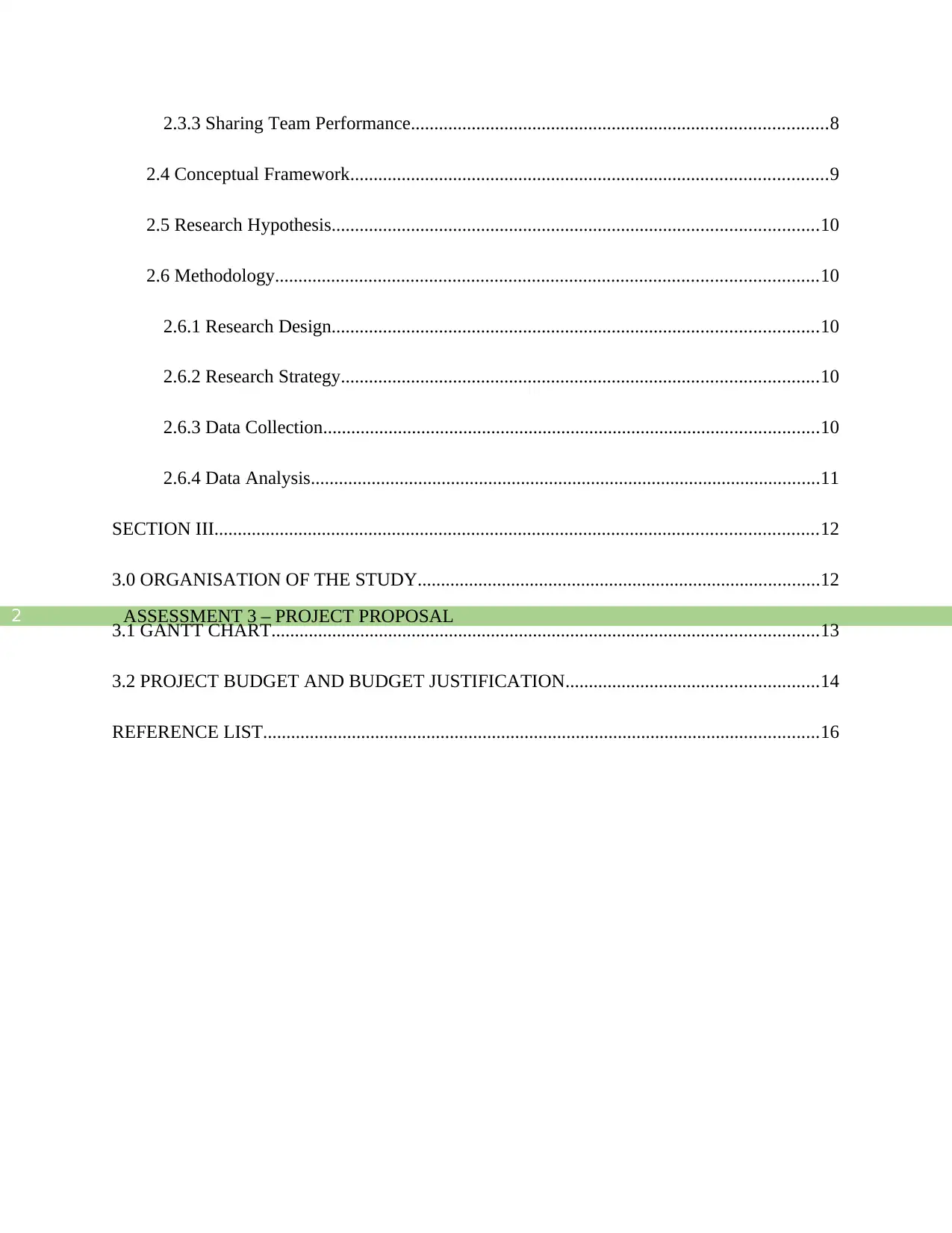
ASSESSMENT 3 – PROJECT PROPOSAL2
2.3.3 Sharing Team Performance.........................................................................................8
2.4 Conceptual Framework......................................................................................................9
2.5 Research Hypothesis........................................................................................................10
2.6 Methodology....................................................................................................................10
2.6.1 Research Design........................................................................................................10
2.6.2 Research Strategy......................................................................................................10
2.6.3 Data Collection..........................................................................................................10
2.6.4 Data Analysis.............................................................................................................11
SECTION III.................................................................................................................................12
3.0 ORGANISATION OF THE STUDY......................................................................................12
3.1 GANTT CHART.....................................................................................................................13
3.2 PROJECT BUDGET AND BUDGET JUSTIFICATION......................................................14
REFERENCE LIST.......................................................................................................................16
2.3.3 Sharing Team Performance.........................................................................................8
2.4 Conceptual Framework......................................................................................................9
2.5 Research Hypothesis........................................................................................................10
2.6 Methodology....................................................................................................................10
2.6.1 Research Design........................................................................................................10
2.6.2 Research Strategy......................................................................................................10
2.6.3 Data Collection..........................................................................................................10
2.6.4 Data Analysis.............................................................................................................11
SECTION III.................................................................................................................................12
3.0 ORGANISATION OF THE STUDY......................................................................................12
3.1 GANTT CHART.....................................................................................................................13
3.2 PROJECT BUDGET AND BUDGET JUSTIFICATION......................................................14
REFERENCE LIST.......................................................................................................................16
⊘ This is a preview!⊘
Do you want full access?
Subscribe today to unlock all pages.

Trusted by 1+ million students worldwide
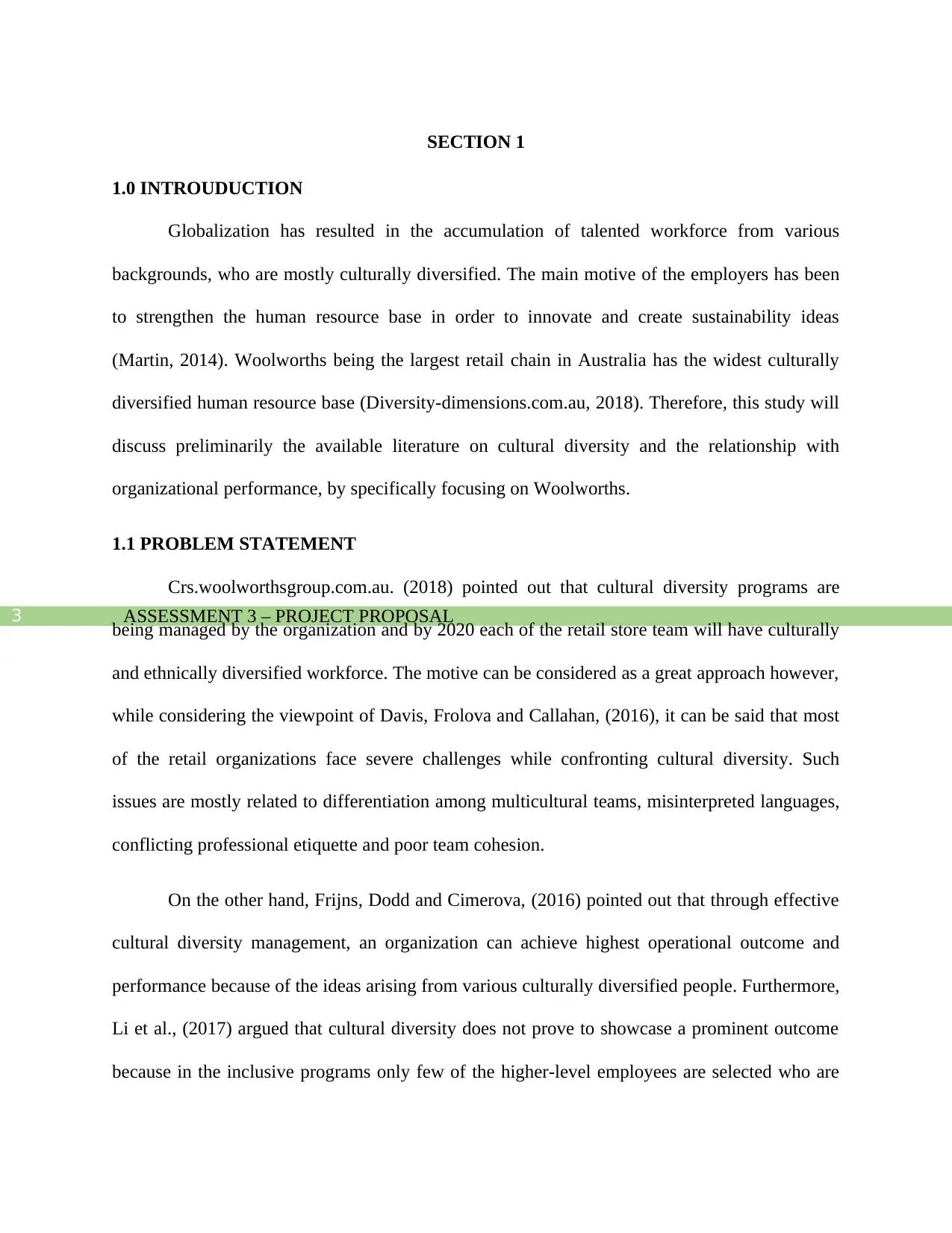
ASSESSMENT 3 – PROJECT PROPOSAL3
SECTION 1
1.0 INTROUDUCTION
Globalization has resulted in the accumulation of talented workforce from various
backgrounds, who are mostly culturally diversified. The main motive of the employers has been
to strengthen the human resource base in order to innovate and create sustainability ideas
(Martin, 2014). Woolworths being the largest retail chain in Australia has the widest culturally
diversified human resource base (Diversity-dimensions.com.au, 2018). Therefore, this study will
discuss preliminarily the available literature on cultural diversity and the relationship with
organizational performance, by specifically focusing on Woolworths.
1.1 PROBLEM STATEMENT
Crs.woolworthsgroup.com.au. (2018) pointed out that cultural diversity programs are
being managed by the organization and by 2020 each of the retail store team will have culturally
and ethnically diversified workforce. The motive can be considered as a great approach however,
while considering the viewpoint of Davis, Frolova and Callahan, (2016), it can be said that most
of the retail organizations face severe challenges while confronting cultural diversity. Such
issues are mostly related to differentiation among multicultural teams, misinterpreted languages,
conflicting professional etiquette and poor team cohesion.
On the other hand, Frijns, Dodd and Cimerova, (2016) pointed out that through effective
cultural diversity management, an organization can achieve highest operational outcome and
performance because of the ideas arising from various culturally diversified people. Furthermore,
Li et al., (2017) argued that cultural diversity does not prove to showcase a prominent outcome
because in the inclusive programs only few of the higher-level employees are selected who are
SECTION 1
1.0 INTROUDUCTION
Globalization has resulted in the accumulation of talented workforce from various
backgrounds, who are mostly culturally diversified. The main motive of the employers has been
to strengthen the human resource base in order to innovate and create sustainability ideas
(Martin, 2014). Woolworths being the largest retail chain in Australia has the widest culturally
diversified human resource base (Diversity-dimensions.com.au, 2018). Therefore, this study will
discuss preliminarily the available literature on cultural diversity and the relationship with
organizational performance, by specifically focusing on Woolworths.
1.1 PROBLEM STATEMENT
Crs.woolworthsgroup.com.au. (2018) pointed out that cultural diversity programs are
being managed by the organization and by 2020 each of the retail store team will have culturally
and ethnically diversified workforce. The motive can be considered as a great approach however,
while considering the viewpoint of Davis, Frolova and Callahan, (2016), it can be said that most
of the retail organizations face severe challenges while confronting cultural diversity. Such
issues are mostly related to differentiation among multicultural teams, misinterpreted languages,
conflicting professional etiquette and poor team cohesion.
On the other hand, Frijns, Dodd and Cimerova, (2016) pointed out that through effective
cultural diversity management, an organization can achieve highest operational outcome and
performance because of the ideas arising from various culturally diversified people. Furthermore,
Li et al., (2017) argued that cultural diversity does not prove to showcase a prominent outcome
because in the inclusive programs only few of the higher-level employees are selected who are
Paraphrase This Document
Need a fresh take? Get an instant paraphrase of this document with our AI Paraphraser
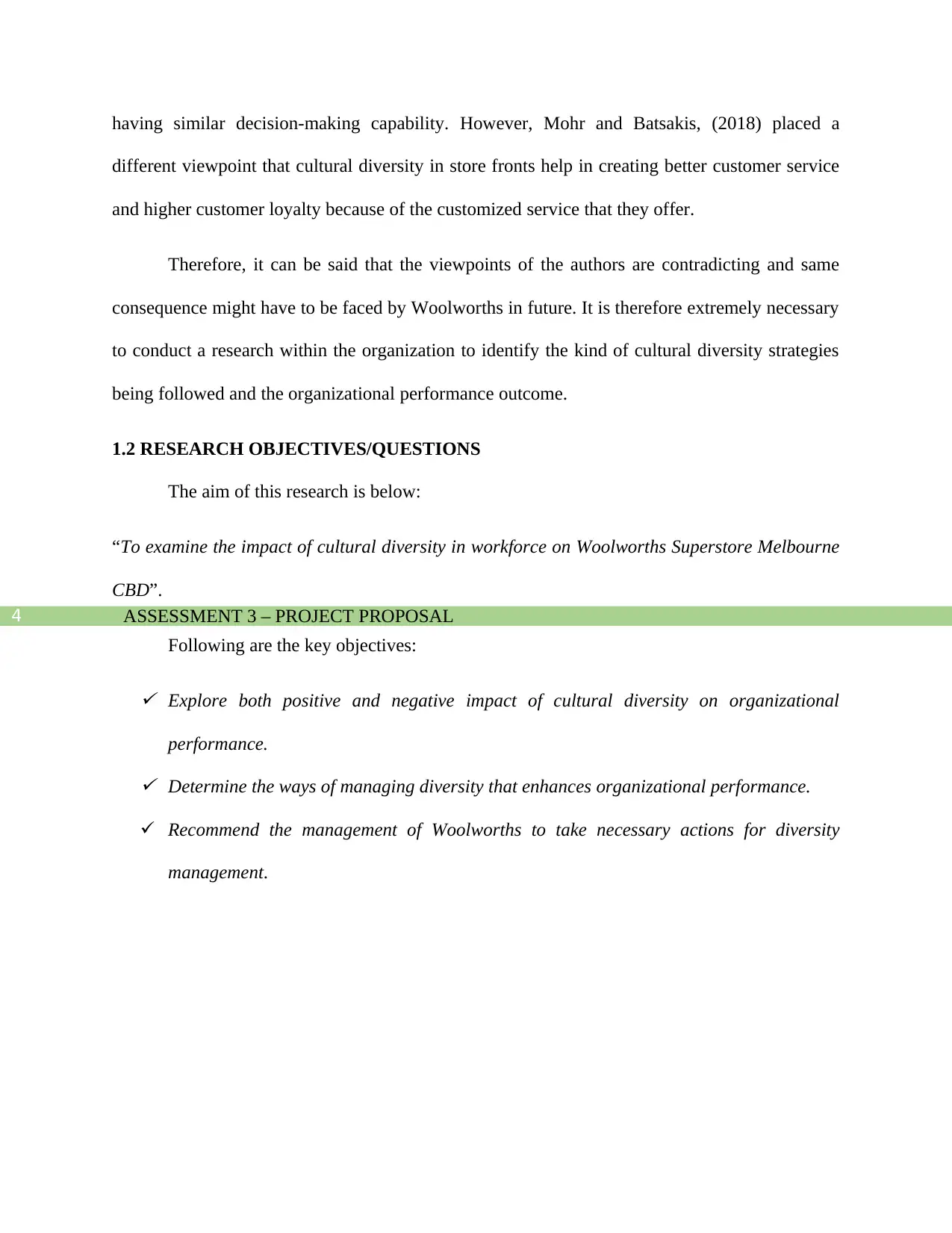
ASSESSMENT 3 – PROJECT PROPOSAL4
having similar decision-making capability. However, Mohr and Batsakis, (2018) placed a
different viewpoint that cultural diversity in store fronts help in creating better customer service
and higher customer loyalty because of the customized service that they offer.
Therefore, it can be said that the viewpoints of the authors are contradicting and same
consequence might have to be faced by Woolworths in future. It is therefore extremely necessary
to conduct a research within the organization to identify the kind of cultural diversity strategies
being followed and the organizational performance outcome.
1.2 RESEARCH OBJECTIVES/QUESTIONS
The aim of this research is below:
“To examine the impact of cultural diversity in workforce on Woolworths Superstore Melbourne
CBD”.
Following are the key objectives:
Explore both positive and negative impact of cultural diversity on organizational
performance. Determine the ways of managing diversity that enhances organizational performance.
Recommend the management of Woolworths to take necessary actions for diversity
management.
having similar decision-making capability. However, Mohr and Batsakis, (2018) placed a
different viewpoint that cultural diversity in store fronts help in creating better customer service
and higher customer loyalty because of the customized service that they offer.
Therefore, it can be said that the viewpoints of the authors are contradicting and same
consequence might have to be faced by Woolworths in future. It is therefore extremely necessary
to conduct a research within the organization to identify the kind of cultural diversity strategies
being followed and the organizational performance outcome.
1.2 RESEARCH OBJECTIVES/QUESTIONS
The aim of this research is below:
“To examine the impact of cultural diversity in workforce on Woolworths Superstore Melbourne
CBD”.
Following are the key objectives:
Explore both positive and negative impact of cultural diversity on organizational
performance. Determine the ways of managing diversity that enhances organizational performance.
Recommend the management of Woolworths to take necessary actions for diversity
management.
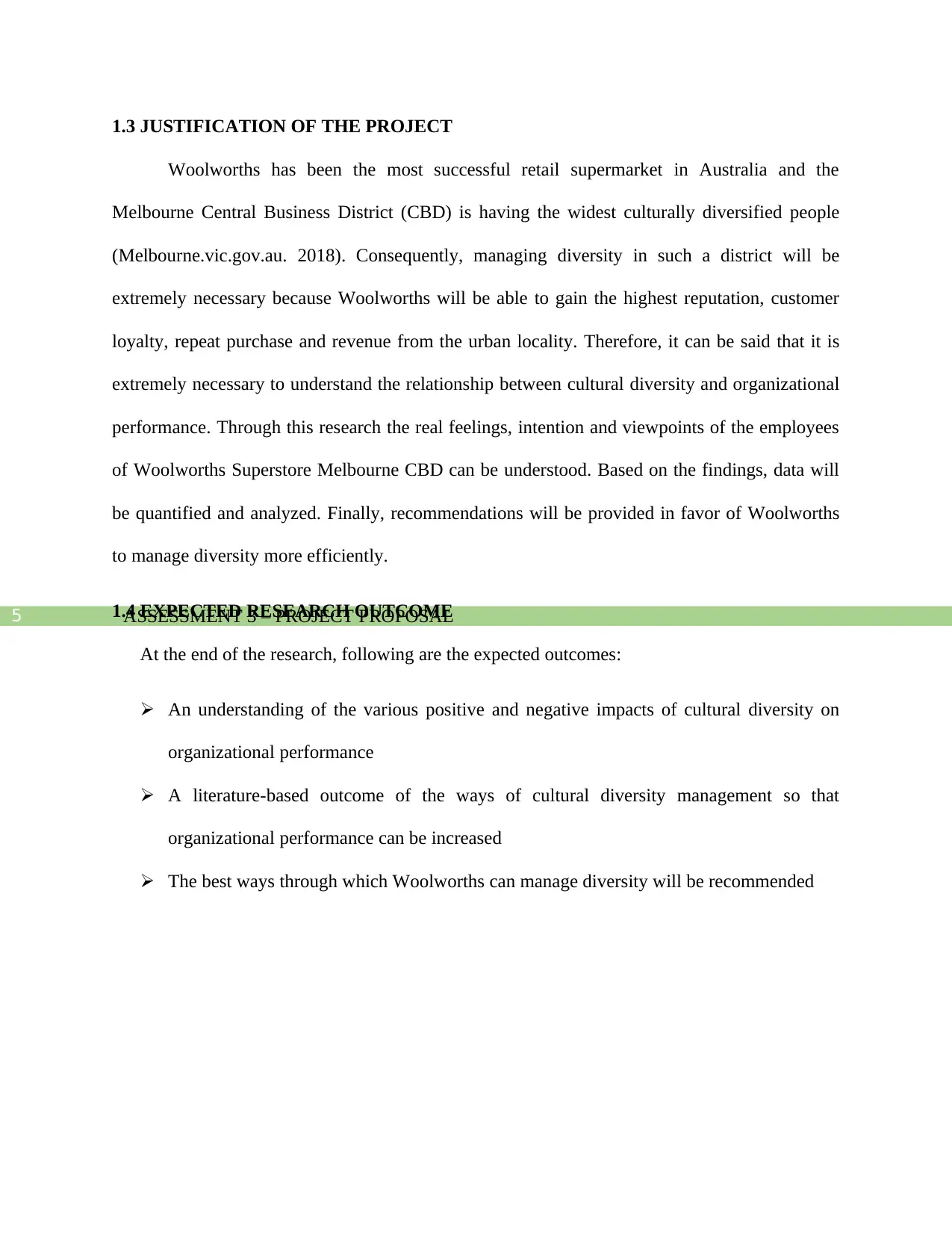
ASSESSMENT 3 – PROJECT PROPOSAL5
1.3 JUSTIFICATION OF THE PROJECT
Woolworths has been the most successful retail supermarket in Australia and the
Melbourne Central Business District (CBD) is having the widest culturally diversified people
(Melbourne.vic.gov.au. 2018). Consequently, managing diversity in such a district will be
extremely necessary because Woolworths will be able to gain the highest reputation, customer
loyalty, repeat purchase and revenue from the urban locality. Therefore, it can be said that it is
extremely necessary to understand the relationship between cultural diversity and organizational
performance. Through this research the real feelings, intention and viewpoints of the employees
of Woolworths Superstore Melbourne CBD can be understood. Based on the findings, data will
be quantified and analyzed. Finally, recommendations will be provided in favor of Woolworths
to manage diversity more efficiently.
1.4 EXPECTED RESEARCH OUTCOME
At the end of the research, following are the expected outcomes:
An understanding of the various positive and negative impacts of cultural diversity on
organizational performance
A literature-based outcome of the ways of cultural diversity management so that
organizational performance can be increased
The best ways through which Woolworths can manage diversity will be recommended
1.3 JUSTIFICATION OF THE PROJECT
Woolworths has been the most successful retail supermarket in Australia and the
Melbourne Central Business District (CBD) is having the widest culturally diversified people
(Melbourne.vic.gov.au. 2018). Consequently, managing diversity in such a district will be
extremely necessary because Woolworths will be able to gain the highest reputation, customer
loyalty, repeat purchase and revenue from the urban locality. Therefore, it can be said that it is
extremely necessary to understand the relationship between cultural diversity and organizational
performance. Through this research the real feelings, intention and viewpoints of the employees
of Woolworths Superstore Melbourne CBD can be understood. Based on the findings, data will
be quantified and analyzed. Finally, recommendations will be provided in favor of Woolworths
to manage diversity more efficiently.
1.4 EXPECTED RESEARCH OUTCOME
At the end of the research, following are the expected outcomes:
An understanding of the various positive and negative impacts of cultural diversity on
organizational performance
A literature-based outcome of the ways of cultural diversity management so that
organizational performance can be increased
The best ways through which Woolworths can manage diversity will be recommended
⊘ This is a preview!⊘
Do you want full access?
Subscribe today to unlock all pages.

Trusted by 1+ million students worldwide
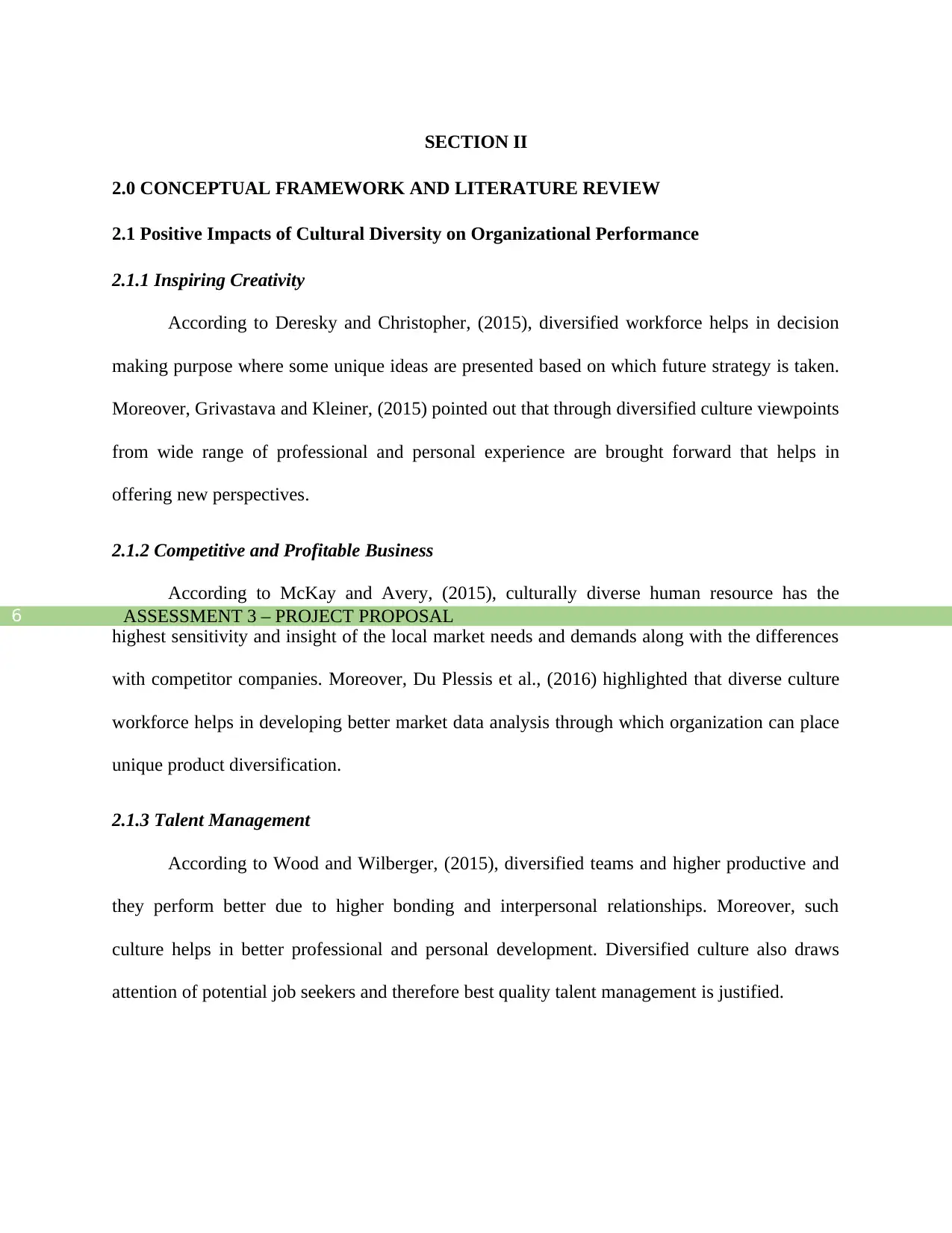
ASSESSMENT 3 – PROJECT PROPOSAL6
SECTION II
2.0 CONCEPTUAL FRAMEWORK AND LITERATURE REVIEW
2.1 Positive Impacts of Cultural Diversity on Organizational Performance
2.1.1 Inspiring Creativity
According to Deresky and Christopher, (2015), diversified workforce helps in decision
making purpose where some unique ideas are presented based on which future strategy is taken.
Moreover, Grivastava and Kleiner, (2015) pointed out that through diversified culture viewpoints
from wide range of professional and personal experience are brought forward that helps in
offering new perspectives.
2.1.2 Competitive and Profitable Business
According to McKay and Avery, (2015), culturally diverse human resource has the
highest sensitivity and insight of the local market needs and demands along with the differences
with competitor companies. Moreover, Du Plessis et al., (2016) highlighted that diverse culture
workforce helps in developing better market data analysis through which organization can place
unique product diversification.
2.1.3 Talent Management
According to Wood and Wilberger, (2015), diversified teams and higher productive and
they perform better due to higher bonding and interpersonal relationships. Moreover, such
culture helps in better professional and personal development. Diversified culture also draws
attention of potential job seekers and therefore best quality talent management is justified.
SECTION II
2.0 CONCEPTUAL FRAMEWORK AND LITERATURE REVIEW
2.1 Positive Impacts of Cultural Diversity on Organizational Performance
2.1.1 Inspiring Creativity
According to Deresky and Christopher, (2015), diversified workforce helps in decision
making purpose where some unique ideas are presented based on which future strategy is taken.
Moreover, Grivastava and Kleiner, (2015) pointed out that through diversified culture viewpoints
from wide range of professional and personal experience are brought forward that helps in
offering new perspectives.
2.1.2 Competitive and Profitable Business
According to McKay and Avery, (2015), culturally diverse human resource has the
highest sensitivity and insight of the local market needs and demands along with the differences
with competitor companies. Moreover, Du Plessis et al., (2016) highlighted that diverse culture
workforce helps in developing better market data analysis through which organization can place
unique product diversification.
2.1.3 Talent Management
According to Wood and Wilberger, (2015), diversified teams and higher productive and
they perform better due to higher bonding and interpersonal relationships. Moreover, such
culture helps in better professional and personal development. Diversified culture also draws
attention of potential job seekers and therefore best quality talent management is justified.
Paraphrase This Document
Need a fresh take? Get an instant paraphrase of this document with our AI Paraphraser
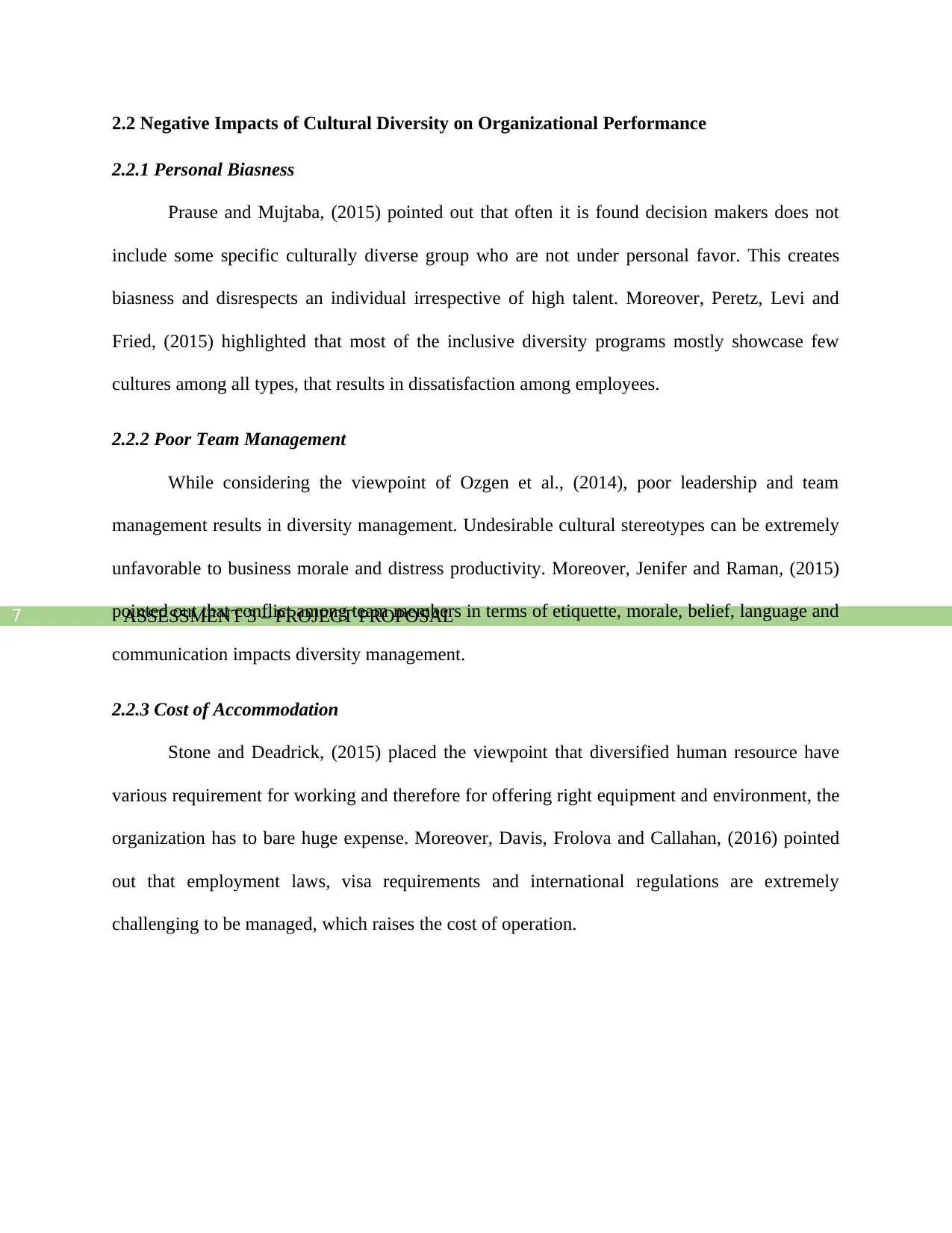
ASSESSMENT 3 – PROJECT PROPOSAL7
2.2 Negative Impacts of Cultural Diversity on Organizational Performance
2.2.1 Personal Biasness
Prause and Mujtaba, (2015) pointed out that often it is found decision makers does not
include some specific culturally diverse group who are not under personal favor. This creates
biasness and disrespects an individual irrespective of high talent. Moreover, Peretz, Levi and
Fried, (2015) highlighted that most of the inclusive diversity programs mostly showcase few
cultures among all types, that results in dissatisfaction among employees.
2.2.2 Poor Team Management
While considering the viewpoint of Ozgen et al., (2014), poor leadership and team
management results in diversity management. Undesirable cultural stereotypes can be extremely
unfavorable to business morale and distress productivity. Moreover, Jenifer and Raman, (2015)
pointed out that conflict among team members in terms of etiquette, morale, belief, language and
communication impacts diversity management.
2.2.3 Cost of Accommodation
Stone and Deadrick, (2015) placed the viewpoint that diversified human resource have
various requirement for working and therefore for offering right equipment and environment, the
organization has to bare huge expense. Moreover, Davis, Frolova and Callahan, (2016) pointed
out that employment laws, visa requirements and international regulations are extremely
challenging to be managed, which raises the cost of operation.
2.2 Negative Impacts of Cultural Diversity on Organizational Performance
2.2.1 Personal Biasness
Prause and Mujtaba, (2015) pointed out that often it is found decision makers does not
include some specific culturally diverse group who are not under personal favor. This creates
biasness and disrespects an individual irrespective of high talent. Moreover, Peretz, Levi and
Fried, (2015) highlighted that most of the inclusive diversity programs mostly showcase few
cultures among all types, that results in dissatisfaction among employees.
2.2.2 Poor Team Management
While considering the viewpoint of Ozgen et al., (2014), poor leadership and team
management results in diversity management. Undesirable cultural stereotypes can be extremely
unfavorable to business morale and distress productivity. Moreover, Jenifer and Raman, (2015)
pointed out that conflict among team members in terms of etiquette, morale, belief, language and
communication impacts diversity management.
2.2.3 Cost of Accommodation
Stone and Deadrick, (2015) placed the viewpoint that diversified human resource have
various requirement for working and therefore for offering right equipment and environment, the
organization has to bare huge expense. Moreover, Davis, Frolova and Callahan, (2016) pointed
out that employment laws, visa requirements and international regulations are extremely
challenging to be managed, which raises the cost of operation.
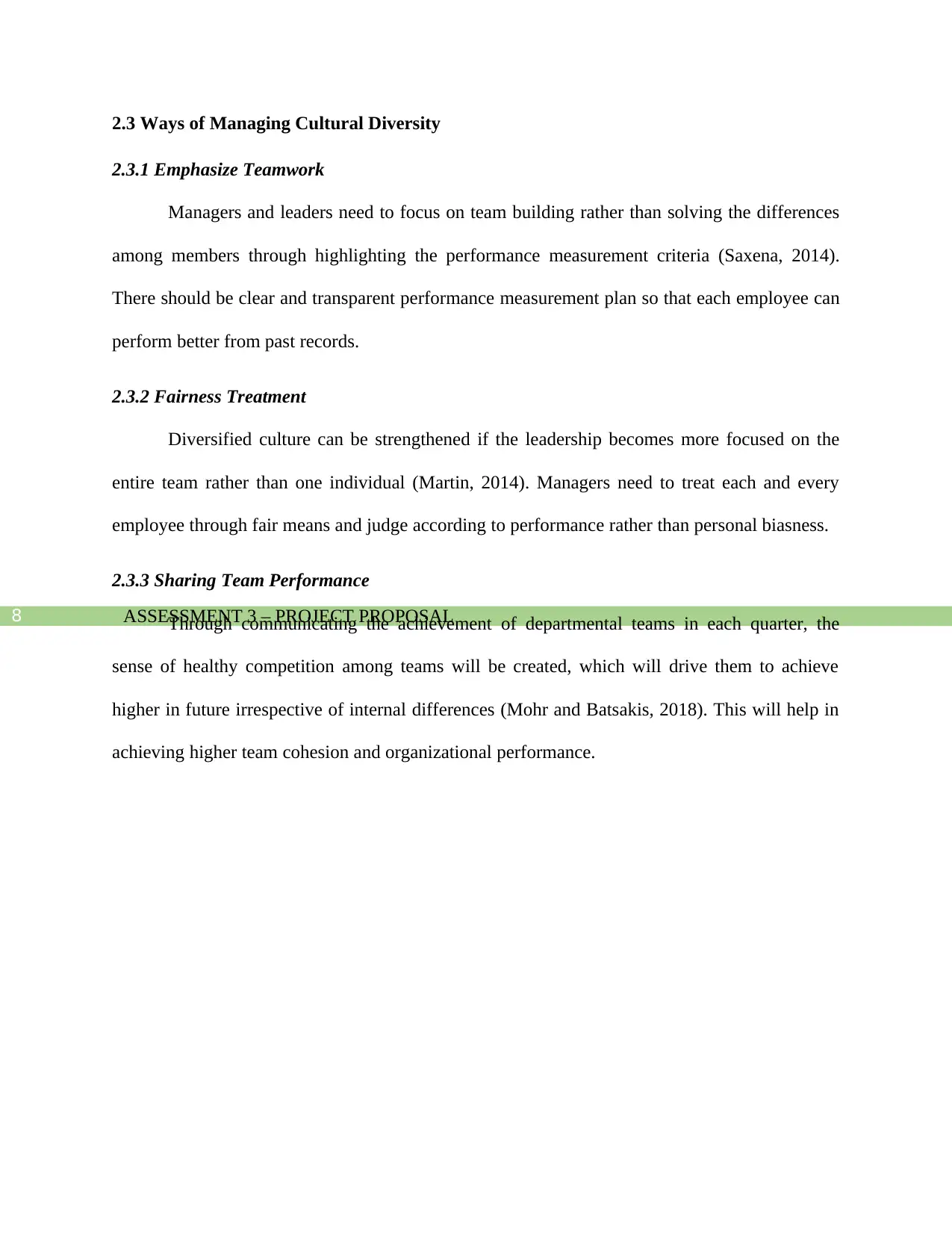
ASSESSMENT 3 – PROJECT PROPOSAL8
2.3 Ways of Managing Cultural Diversity
2.3.1 Emphasize Teamwork
Managers and leaders need to focus on team building rather than solving the differences
among members through highlighting the performance measurement criteria (Saxena, 2014).
There should be clear and transparent performance measurement plan so that each employee can
perform better from past records.
2.3.2 Fairness Treatment
Diversified culture can be strengthened if the leadership becomes more focused on the
entire team rather than one individual (Martin, 2014). Managers need to treat each and every
employee through fair means and judge according to performance rather than personal biasness.
2.3.3 Sharing Team Performance
Through communicating the achievement of departmental teams in each quarter, the
sense of healthy competition among teams will be created, which will drive them to achieve
higher in future irrespective of internal differences (Mohr and Batsakis, 2018). This will help in
achieving higher team cohesion and organizational performance.
2.3 Ways of Managing Cultural Diversity
2.3.1 Emphasize Teamwork
Managers and leaders need to focus on team building rather than solving the differences
among members through highlighting the performance measurement criteria (Saxena, 2014).
There should be clear and transparent performance measurement plan so that each employee can
perform better from past records.
2.3.2 Fairness Treatment
Diversified culture can be strengthened if the leadership becomes more focused on the
entire team rather than one individual (Martin, 2014). Managers need to treat each and every
employee through fair means and judge according to performance rather than personal biasness.
2.3.3 Sharing Team Performance
Through communicating the achievement of departmental teams in each quarter, the
sense of healthy competition among teams will be created, which will drive them to achieve
higher in future irrespective of internal differences (Mohr and Batsakis, 2018). This will help in
achieving higher team cohesion and organizational performance.
⊘ This is a preview!⊘
Do you want full access?
Subscribe today to unlock all pages.

Trusted by 1+ million students worldwide
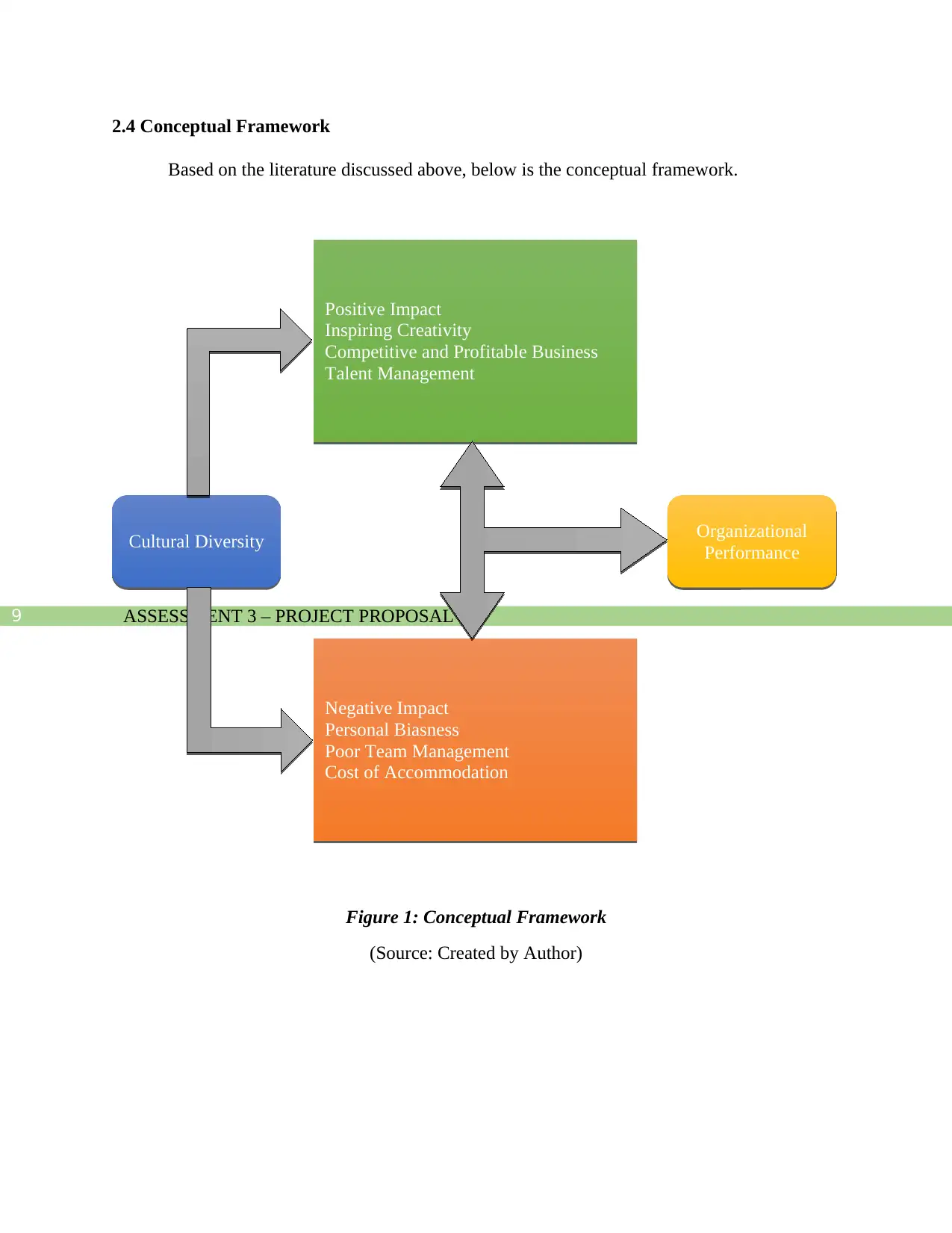
ASSESSMENT 3 – PROJECT PROPOSAL9
2.4 Conceptual Framework
Based on the literature discussed above, below is the conceptual framework.
Figure 1: Conceptual Framework
(Source: Created by Author)Cultural Diversity
Cultural DiversityOrganizational
Performance Organizational
PerformancePositive Impact
Inspiring Creativity
Competitive and Profitable Business
Talent Management
Positive Impact
Inspiring Creativity
Competitive and Profitable Business
Talent ManagementNegative Impact
Personal Biasness
Poor Team Management
Cost of Accommodation
Negative Impact
Personal Biasness
Poor Team Management
Cost of Accommodation
2.4 Conceptual Framework
Based on the literature discussed above, below is the conceptual framework.
Figure 1: Conceptual Framework
(Source: Created by Author)Cultural Diversity
Cultural DiversityOrganizational
Performance Organizational
PerformancePositive Impact
Inspiring Creativity
Competitive and Profitable Business
Talent Management
Positive Impact
Inspiring Creativity
Competitive and Profitable Business
Talent ManagementNegative Impact
Personal Biasness
Poor Team Management
Cost of Accommodation
Negative Impact
Personal Biasness
Poor Team Management
Cost of Accommodation
Paraphrase This Document
Need a fresh take? Get an instant paraphrase of this document with our AI Paraphraser
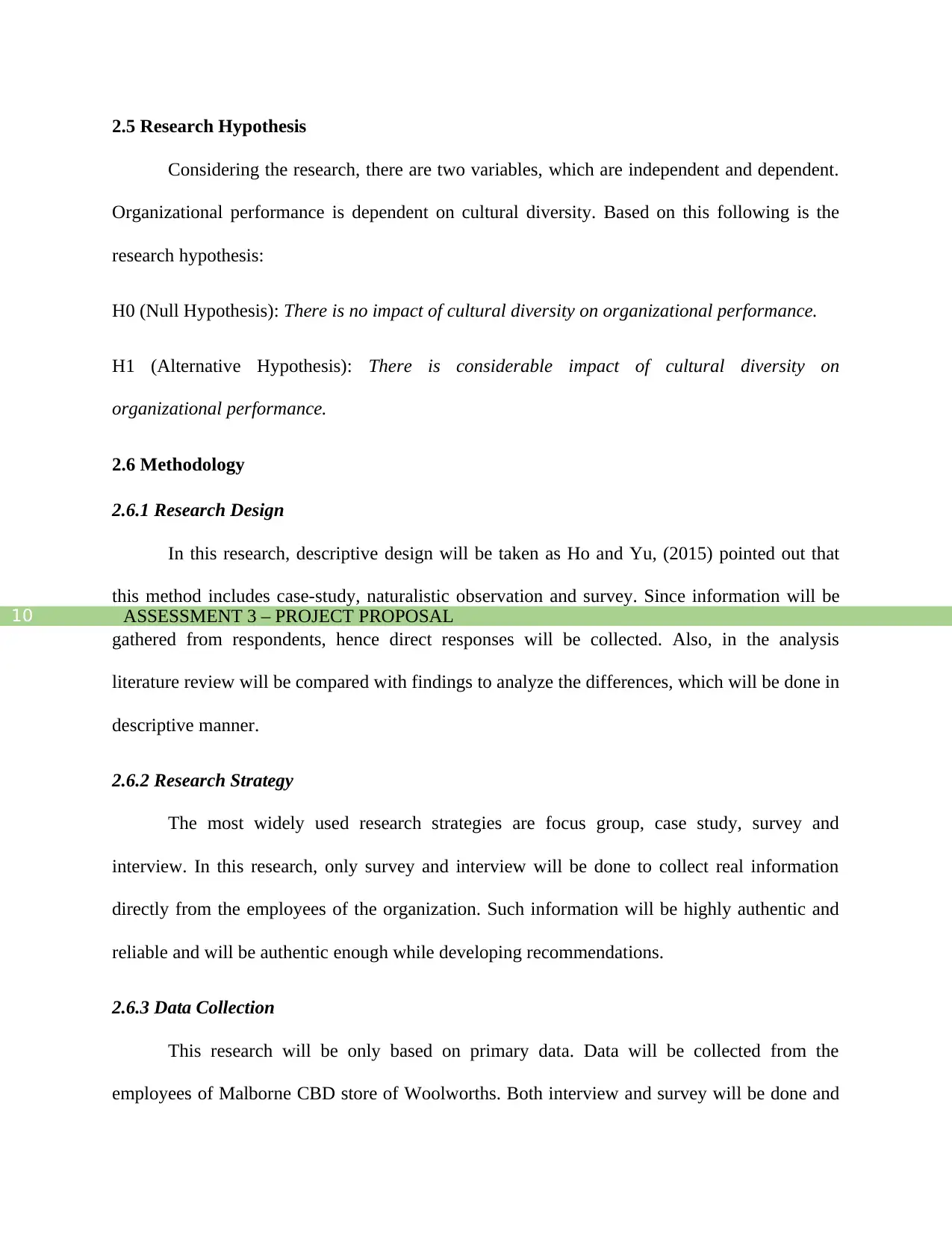
ASSESSMENT 3 – PROJECT PROPOSAL10
2.5 Research Hypothesis
Considering the research, there are two variables, which are independent and dependent.
Organizational performance is dependent on cultural diversity. Based on this following is the
research hypothesis:
H0 (Null Hypothesis): There is no impact of cultural diversity on organizational performance.
H1 (Alternative Hypothesis): There is considerable impact of cultural diversity on
organizational performance.
2.6 Methodology
2.6.1 Research Design
In this research, descriptive design will be taken as Ho and Yu, (2015) pointed out that
this method includes case-study, naturalistic observation and survey. Since information will be
gathered from respondents, hence direct responses will be collected. Also, in the analysis
literature review will be compared with findings to analyze the differences, which will be done in
descriptive manner.
2.6.2 Research Strategy
The most widely used research strategies are focus group, case study, survey and
interview. In this research, only survey and interview will be done to collect real information
directly from the employees of the organization. Such information will be highly authentic and
reliable and will be authentic enough while developing recommendations.
2.6.3 Data Collection
This research will be only based on primary data. Data will be collected from the
employees of Malborne CBD store of Woolworths. Both interview and survey will be done and
2.5 Research Hypothesis
Considering the research, there are two variables, which are independent and dependent.
Organizational performance is dependent on cultural diversity. Based on this following is the
research hypothesis:
H0 (Null Hypothesis): There is no impact of cultural diversity on organizational performance.
H1 (Alternative Hypothesis): There is considerable impact of cultural diversity on
organizational performance.
2.6 Methodology
2.6.1 Research Design
In this research, descriptive design will be taken as Ho and Yu, (2015) pointed out that
this method includes case-study, naturalistic observation and survey. Since information will be
gathered from respondents, hence direct responses will be collected. Also, in the analysis
literature review will be compared with findings to analyze the differences, which will be done in
descriptive manner.
2.6.2 Research Strategy
The most widely used research strategies are focus group, case study, survey and
interview. In this research, only survey and interview will be done to collect real information
directly from the employees of the organization. Such information will be highly authentic and
reliable and will be authentic enough while developing recommendations.
2.6.3 Data Collection
This research will be only based on primary data. Data will be collected from the
employees of Malborne CBD store of Woolworths. Both interview and survey will be done and
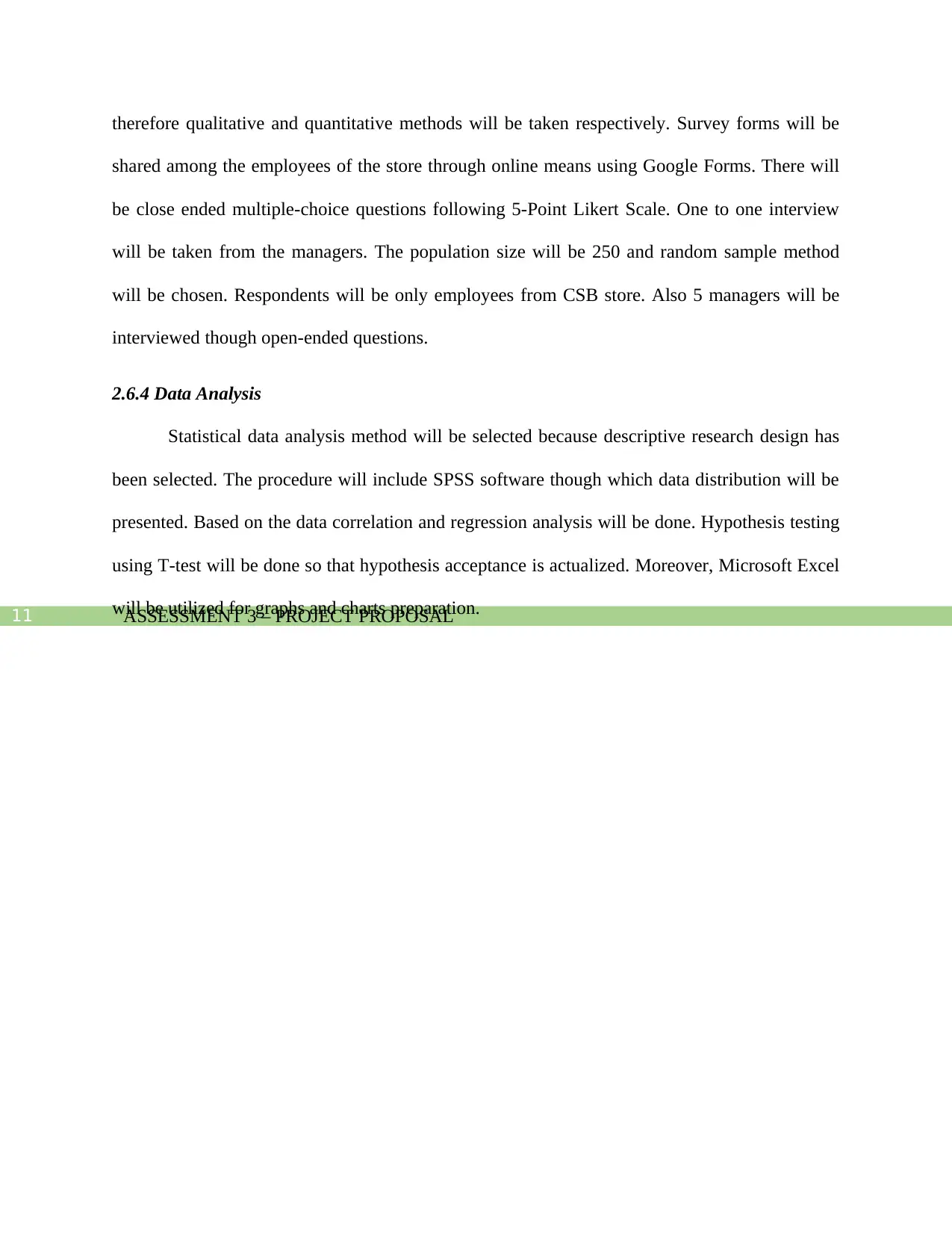
ASSESSMENT 3 – PROJECT PROPOSAL11
therefore qualitative and quantitative methods will be taken respectively. Survey forms will be
shared among the employees of the store through online means using Google Forms. There will
be close ended multiple-choice questions following 5-Point Likert Scale. One to one interview
will be taken from the managers. The population size will be 250 and random sample method
will be chosen. Respondents will be only employees from CSB store. Also 5 managers will be
interviewed though open-ended questions.
2.6.4 Data Analysis
Statistical data analysis method will be selected because descriptive research design has
been selected. The procedure will include SPSS software though which data distribution will be
presented. Based on the data correlation and regression analysis will be done. Hypothesis testing
using T-test will be done so that hypothesis acceptance is actualized. Moreover, Microsoft Excel
will be utilized for graphs and charts preparation.
therefore qualitative and quantitative methods will be taken respectively. Survey forms will be
shared among the employees of the store through online means using Google Forms. There will
be close ended multiple-choice questions following 5-Point Likert Scale. One to one interview
will be taken from the managers. The population size will be 250 and random sample method
will be chosen. Respondents will be only employees from CSB store. Also 5 managers will be
interviewed though open-ended questions.
2.6.4 Data Analysis
Statistical data analysis method will be selected because descriptive research design has
been selected. The procedure will include SPSS software though which data distribution will be
presented. Based on the data correlation and regression analysis will be done. Hypothesis testing
using T-test will be done so that hypothesis acceptance is actualized. Moreover, Microsoft Excel
will be utilized for graphs and charts preparation.
⊘ This is a preview!⊘
Do you want full access?
Subscribe today to unlock all pages.

Trusted by 1+ million students worldwide
1 out of 19
Related Documents
Your All-in-One AI-Powered Toolkit for Academic Success.
+13062052269
info@desklib.com
Available 24*7 on WhatsApp / Email
![[object Object]](/_next/static/media/star-bottom.7253800d.svg)
Unlock your academic potential
Copyright © 2020–2025 A2Z Services. All Rights Reserved. Developed and managed by ZUCOL.





